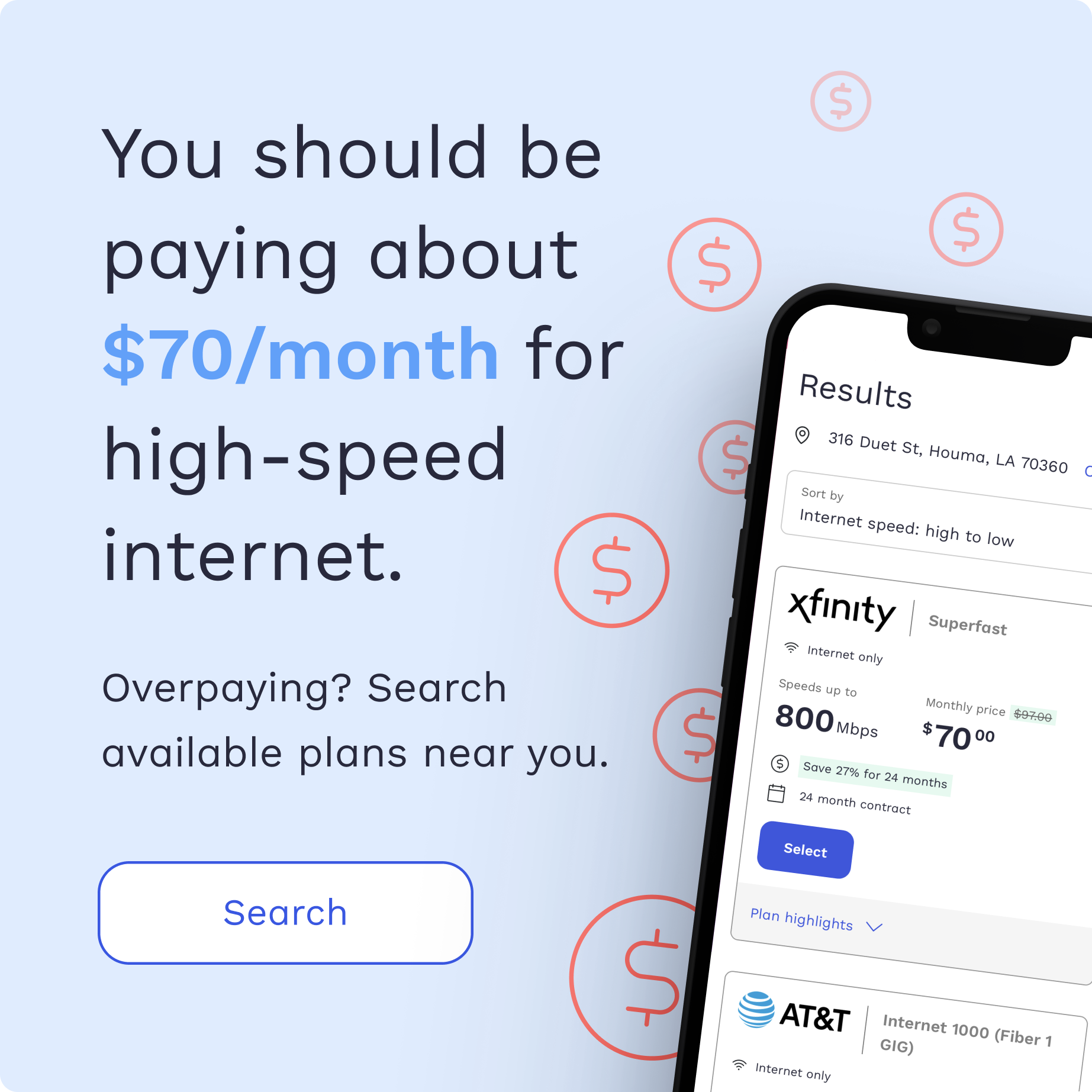What’s the Best Cable TV Alternative?

Moving soon? Get organized with our free moving checklist.
Gone are the days when cable TV was king. Today, more people than ever are joining the ranks of cable cutters. In fact, according to Forbes the number of people who cancelled their cable or satellite service more than tripled between 2014 and 2021 — growing from 15.6 million to about 50.4 million households who’ve made the switch to a cable TV alternative.
If you’re interested in saving money on your monthly cable bill or are just curious about how cable TV alternatives compare, this comprehensive guide is for you. We’ve compiled insights about what the biggest players in this field have to offer to help you find the right alternative to cable TV.
The big players
Though Netflix is often credited with starting the cord cutting revolution, there is stiff competition among cable TV alternatives. At one time, many of these services were either solely for streaming movies and shows or solely for live TV. Now, many offer a variety of options so you can find a cable TV alternative that meets all of your needs.
Netflix
Netflix started in 1998 as a way to rent DVDs through the mail and introduced streaming services almost a decade later. As of 2022, the company has over 200 million monthly subscribers and offers three plans to choose from, none of which require a contract: $9.99/month for Basic (SD), $15.49/month for Standard (HD), or $19.99/month for Premium (4K Ultra HD). While other streaming services have introduced add-on options such as live TV or partner plans with other networks, Netflix prides itself on keeping its options simple.
Hulu
Hulu launched in 2007, right around the time that Netflix began offering streaming services. While Hulu was originally a streaming-only service, the company has expanded its offerings with options to bundle additional services. Their most popular streaming-only plan starts at $6.99/month and is ad-supported, but you can upgrade to an ad-free version starting at $12.99/month. If you’re a student – you can get Hulu with commercials beginning at $1.99/month.
If you want more than streaming, Hulu offers a variety of bundle options which include Disney+ and ESPN+. These bundles range from $13.99/month (ad-supported) to $19.99/month (no ads) or you can choose to add live TV with 75+ channels for a bundled total of $69.99/month (ad-supported) or $79.99/month (no ads). All Hulu plans are considered month-to-month, which means you don’t have to sign a long-term contract.
Amazon Prime Video
While Amazon Prime Video was originally a perk that was only available to those with an Amazon Prime membership, the service has evolved to allow people to subscribe to Amazon Prime Video only. This is an option many are happy to have since Amazon — similar to Hulu and Netflix — produces a wide variety of original content for viewers that isn’t available anywhere else
Currently, an Amazon Prime membership is either $14.99/month or $139/year. However, if you choose to subscribe to Amazon Prime Video only, the cost starts at $8.99/month. Amazon Prime also offers a discount for students that has all the advantages of Amazon Prime, including Amazon Prime Video, starting at $7.49/month. Additionally, households who qualify for government assistance may be eligible for Amazon Prime prices as low as $6.99/month.
Sling TV
Sling TV is another streaming provider that lets you move away from cable TV. The company offers three plans that range in price from $35/month to $50/month.
The Orange plan offers 32 channels geared toward family programming and the NBA, 50 hours of DVR storage, and the ability to stream on one device for $35/month. The Blue plan offers 42 channels geared toward entertainment and news lovers, 50 hours of DVR storage, and the ability to stream on up to three devices. The Blue plan also starts at $35/month. If you’re looking for the best of both plans, the Orange & Blue package offers 50 channels with a little something for everyone. The plan also includes 50 hours of DVR storage, the ability to stream on up to three devices at a time, and starts at $50/month.
While none of these plans includes an option for local TV channels, Sling TV will provide you with an HD indoor antenna for free if you prepay the first two months of service.
YouTube TV
Similar to Sling TV, YouTube TV is primarily a way to stream live TV through an internet connection. However, YouTube TV also has options to add on streaming video services and premium channels.
YouTube TV’s base package starts at $64.99/month and offers 85+ channels, including the NBA, MLB, and NFL networks, as well as family favorites such as PBS, MTV, and Nickelodeon. This plan also includes unlimited DVR storage, the ability to stream on three devices at once, and no contract.
You can also choose to add on premium channels such as HBO and Starz or specialized sports channels such as Fox Soccer Plus and NFL RedZone for an additional cost. All in all, though later to the game, YouTube TV has positioned itself as a big competitor in the cable TV alternative market.
Key considerations
Before you decide which cable TV alternative is the best fit for you, here are a few things to consider:
Internet speed
Since becoming a cable cutter means you’ll be streaming your TV service through an internet connection, it’s essential to make sure your current internet plan can support your streaming needs. The standard rule of thumb when considering how much internet speed you need for streaming is to have between 25 and 50Mbps of speed for each streaming device.
Budget
Your monthly budget is also a key consideration when determining which cable TV alternative is the best fit for your household. While cutting the cord can lead to cost savings over cable TV service, keep in mind the potential increase in the cost of your internet plan if you need to upgrade your service to support your household’s streaming needs.
Options
The big players in the world of cable TV alternatives offer a variety of services, so it’s up to you to determine which options are most important for your needs. Netflix and Amazon Prime Video only offer on-demand streaming, Sling TV only offers live TV streaming, and Hulu and YouTube TV offer a combination of on-demand streaming, live TV and premium add-ons.
What others are saying
Netflix
“Netflix’s large collection of TV shows and movies, including critically acclaimed originals, make it one of the best video streaming services to date, despite its high cost.” – PCMag
Hulu
“Hulu is one of the top movie and TV streaming services available, thanks to how quickly it airs shows as well its growing slate of originals.” – CNET
Amazon Prime Video
“Overall, [Amazon] Prime Video is a solid pick if you’re looking for award-winning TV and options to keep all your content in one self-contained platform.” – U.S. News & World Report
Sling TV
“No popular streaming service has fully adopted an a la carte model. Still, Sling TV, which offers primarily live content with some video-on-demand options, has gotten pretty close, with topical add-ons available to supplement base packages. This flexibility makes the service a great choice for many cord-cutters.” – U.S. News & World Report
YouTube TV
“With the best channel selection and an unlimited DVR, YouTube TV is the high-end live TV service to choose.” – CNET
Cable TV alternative FAQs
Do these cable TV alternatives require me to sign a contract?
Of the five cable TV alternatives reviewed in this article, all services/plans are considered month-to-month and do not require you to sign a long-term contract.
How do I know what cable TV alternatives are available in my area?
Unlike TV and phone services which typically have limits due to where you live, cable TV alternatives only require you to have high-speed internet of at least 25Mbps. The only options that may be regionally limited are services that offer live TV channels, such as YouTube TV. You’ll need to check with each provider to determine which specific channels are available in your area.












